

Uh oh...
It appears that you're using a severely outdated version of Safari on Windows. Many features won't work correctly, and functionality can't be guaranteed. Please try viewing this website in Edge, Mozilla, Chrome, or another modern browser. Sorry for any inconvenience this may have caused!
Read More about this safari issue.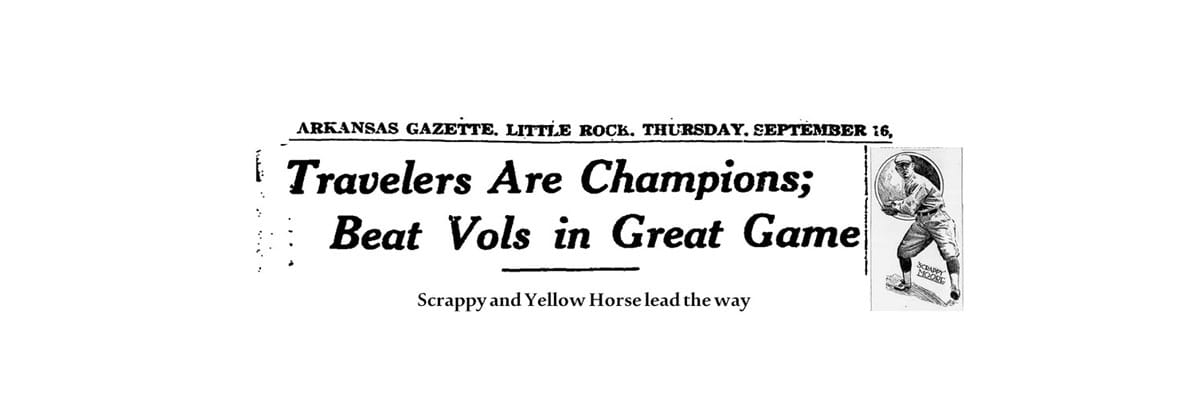

The bold headlines in the September 16, 1920, edition of the Arkansas Gazette announced the historic news to a city that revered its professional baseball team. The beloved Little Rock Travelers had won the city’s first minor league pennant the previous afternoon with a 1 – 0 win over the Nashville Volunteers. Ecstatic Travelers fans awoke to news a standing-room-only crowd had witnessed out at Kavanaugh Park. The Travelers were indeed Champions of the Southern Association that September morning in 1920. The celebration of that first championship occurred 100 years ago this month.
An American Indian from Oklahoma, named Moses Yellow Horse was the winning pitcher that historic evening and a hometown favorite son known locally as “Scrappy” Moore delivered the only run with a fifth-inning single. Scrappy and Yellow Horse were fierce competitors with colorful names that epitomized the collection of memorable characters that inspired a city and set a Traveler’s attendance mark that would stand for 30 years.
The 1920s version of Little Rock Travelers had been purchased in 1915 by local businessman and former player R. G. Allen when the Montgomery franchise in the Southern Association became available. The new team was welcomed back with great enthusiasm. Especially happy to see the Southern Association return was local Judge William Marmaduke Kavanaugh, who was president of the league despite not having a team in his home city. Ironically, Kavanaugh did not live to see the success of the new franchise. Obviously elated to have baseball back in Little Rock, the affable judge was the exuberant host for a party honoring Allen and other league officials on February 20, 1915. The 48-year-old Kavanaugh died the next day with what local newspapers described as “acute indigestion.” The home field of the Travelers, West End Park, was renamed Kavanaugh Field in his honor.
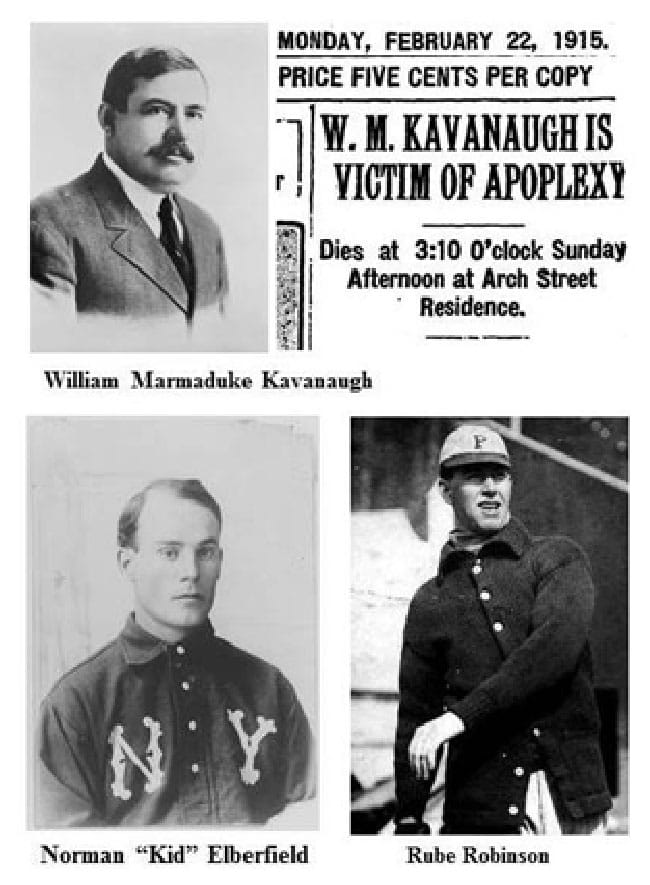
The first three years of the Allen-owned Travelers were a disappointment to both the owner and Little Rock fans. Bob Allen first tried managing himself and later turned to journeyman Charlie Starr with little improvement. By 1918, he was determined to light a fire under the team with a demanding manager. What better man for adding some motivational heat than a colorful little character known as the “Tabasco Kid.” Norman “Kid” Elberfield, at 5’7” and around 150 lbs. was competitive, combative, and often caustic. While his confrontational style was not suited for major league stars, he was the ultimate motivator for young players who wanted to advance.
Elberfield and Allen began 1918 looking for players to move the Travelers to respectability. They found veteran catcher Tony Brottem in Omaha of the Western League and a spunky little infielder named Dutch Distel in Richmond. Both would remain in Little Rock for the championship in 1920. Typically, others came and went, some on the way up and some on the way down, still holding on to a major league dream.
Fortunately, the Travelers did not have to search for an ace starting pitcher. They had one called “Rube Robinson.” Born John Henry Roberson on a White County farm, Rube was a major league pitcher on a minor league team. As a youngster, he had pitched for various teams in the North Arkansas League, posted a 28-win season in the Texas League, and spent four successful summers in the majors. Misidentified early in his career as “Rube Robinson,” his disdain for the major leagues was obvious. He did not like city life, he resented being the “property” of a major league team, and he loved his Arkansas home. On several occasions, he utilized his rural brand of free agency by abruptly leaving his major league team and returning to Arkansas to pitch for the Travelers. The story of the rise of the Little Rock Travelers was very much the story of Rube Robinson.

Moses Yellow Horse
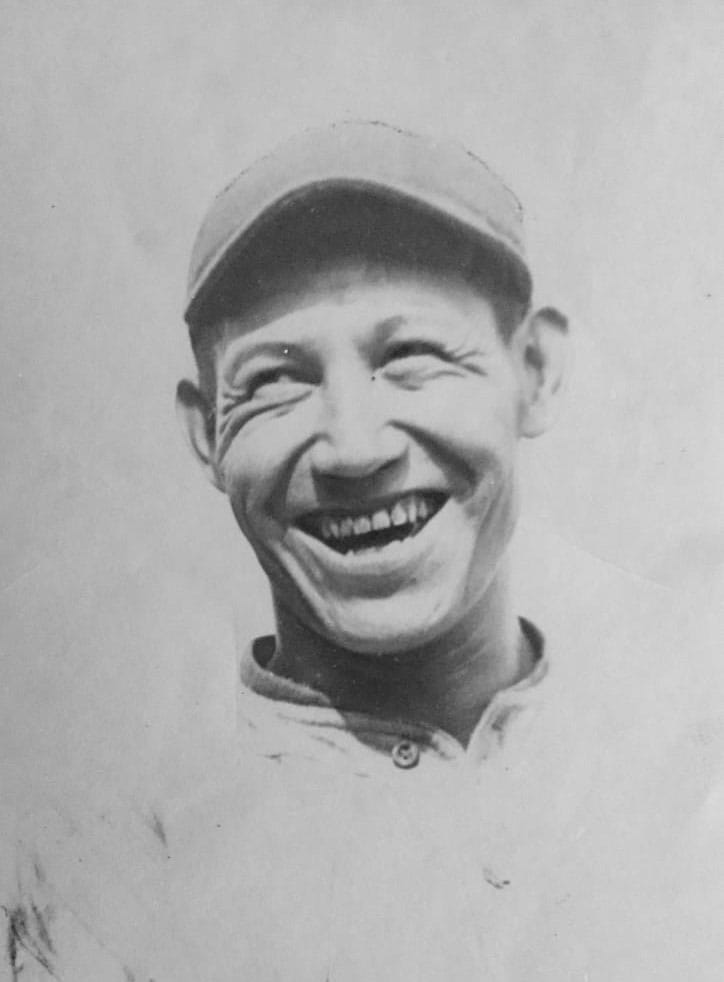
William “Chief” Wano
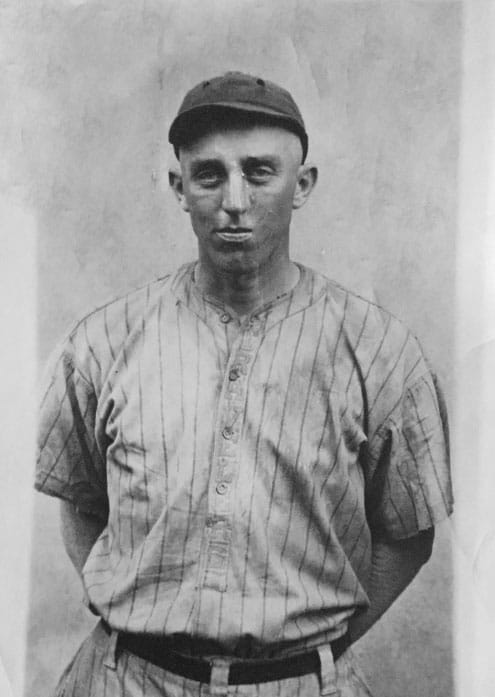
Harry Harper

Bing Miller
After two second-place finishes under Kid Elberfield, the 1920 edition of the Travelers came together with a host of new characters joining Brottem, Distel, and Robinson, in an unlikely assembly of vagabonds and rising stars.
One of the most enigmatic of the new arrivals was a talented outfielder named Harry Harper. A friend of Elberfeld’s in California had recommended Harper and the Travelers found him in Saskatchewan, playing for the Moose Jaw Robin Hoods. Although he had a reputation out west as an outstanding hitter, he had never found a permanent team. Harper would become a formidable weapon in the middle of the Travs lineup.
Joining Harper in the outfield was Edmund John “Bing” Miller an Indiana farm boy bound for major league stardom. A hitch in France during the war had delayed his inevitable ascension to the big leagues. His 1920 summer in Little Rock was the last stop before an outstanding major league career.
Little Rock’s Scrappy Moore was brought in from Atlanta to the delight of the hometown fans. Moore played every game at third base and lived up to his nickname with his grit and extra effort.
And then there were the American Indians…Discovered on a barnstorming trip to Oklahoma after the 1919 season, Elberfield signed Moses Yellow Horse to compliment Robinson on the mound and a slick-fielding, line-drive-hitting first baseman the press would tab as “Chief” Bill Wano.
After dealing with a World War, a pandemic, and a scandal in major league baseball, fans were desperate for a feel-good season. The 1920 Travelers supplied a much-needed remedy for recovering from hard times. From opening day, the Travs were a bigger than life source of entertainment and the darlings of the Little Rock newspapers. Crafting headlines for Kid, Chief, Dutch, Tony, Harp, Scrappy, Bing, Yellow Horse, and Rube was a sports writer’s dream.
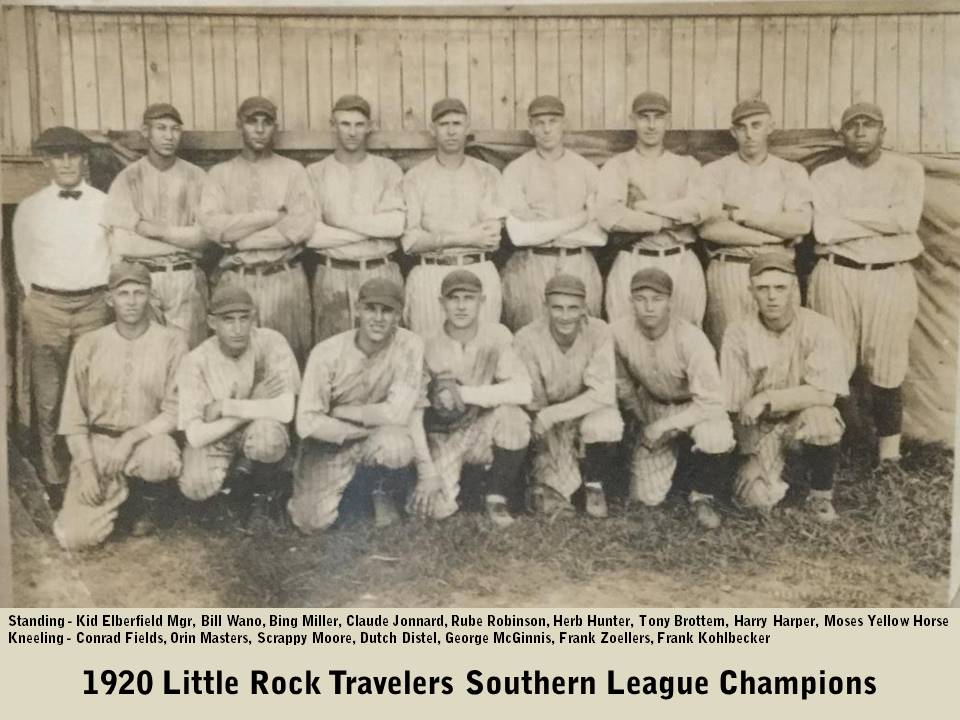
The Travs won on the season’s opening day, but after the first month of the season, they were mired in the middle of the standings. By mid-summer, they recovered and moved into first place ahead of Birmingham and New Orleans. They continued to lead the league until an August swoon left the outcome in doubt. Down the September stretch, with Rube Robinson and Yellow Horse pitching more often, the Travs roared home by winning 18 of their last 22 games. Rube finished with 26 wins to tie for the league lead and Yellow Horse finished 21 – 7 for the best winning percentage in the SA. The pair combined to pitch an amazing 649 innings.
Bing Miller was the most feared hitter in the league. He batted .322, hit 19 home runs and 21 triples. He would begin the next season as the everyday left fielder for the Washington Senators. Miller would play in more than 1800 big league games with a lifetime batting average of .311.
Like Miller, Harry Harper was one of the league’s leading hitters. He led the league in batting average with a .346 mark and looked like a future big-league star. Harry Harper never played in a major league game.
Yellow Horse was signed by the Pirates in the off-season, but never became a major league star. His epitaph reads, “The first full-blooded Indian in the major leagues,” a distinction also claimed by several other Native Americans.
Chief Wano played another season in Little Rock and led the team in most offensive categories. He never made the majors.
Rube Robinson remained a Traveler the next eight seasons, but never approached 26 wins. He is the winningest pitcher (major and minor league combined wins) in Arkansas Baseball history with 330 victories. Rube and Scrappy Moore retired near Little Rock and represented the 1920 team at many honorary events. Rube was inducted into the Arkansas Sports Hall of Fame in 1962.
After two consecutive last-place finishes, Kid Elberfield, the toast of the town in 1920, was fired in 1925. It would be 17 years before the Little Rock Travelers won another pennant, and 31 years before the attendance mark set in 1920 was broken. The Little Rock Travelers became the Arkansas Travelers in 1957.
We do the work.
You check your email.
Sign up for our weekly e-news.
Get stories sent straight to your inbox!










Like this story? Read more from Jim Yeager
At 11:53 p.m. on June 1, a crowd of 11,000-plus at Alex Box Field fell...
Baseball Hall of Famer Bill Dickey was born in Bastrop, Louisiana, on...
On August 8, 1902, Harry Kane, a young man from Hamburg, Arkansas, made...
Join the Conversation
Leave a Comment